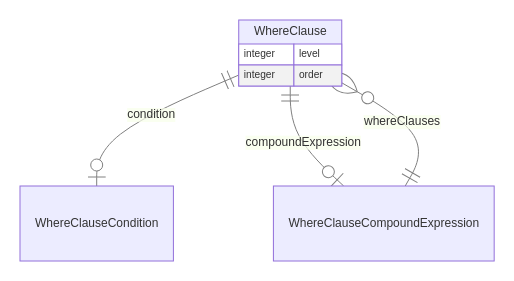Model Documentation
Class: WhereClause
The WhereClause class contains a set of attributes that are used to define data selection criteria. These defined criteria are used for the selection and grouping of subjects and data for analysis. There are 4 "data selection classes" that contain the WhereClause class attributes:
- There are 3 "identified WhereClause classes" that allow an identifier value to be associated with the defined selection criteria (so that the defined criteria can be referenced in the definition of analyses):
- The AnalysisSet class is used to define analysis sets or subject populations (i.e., criteria defined in the protocol or SAP for the selection of subjects for inclusion in the main analyses), as described in the AnalysisSet section.
- The DataSubset class is used to define other types of criteria for the selection of subjects or data records for inclusion in analyses, as described in the DataSubset section.
- The Group class is used to define the criteria for grouping subjects or data records for analysis, as described in the GroupingFactor section.
- The WhereClause class itself may used to define selection criteria being combined or negated in a compound expression (see below).
Each instance of a data selection class defines either (not both) of the following:
- A simple condition expressed as a single dataset variable compared to one or more values (e.g., ADAE.TRTEMFL = "Y", ADSL.AGE > 18, ADSL.TRT01A in ("Drug A", "Drug B")), which is represented in the condition attribute as an instance of the WhereClauseCondition class. See the WhereClauseCondition section for more information about defining simple conditions.
- A compound expression, represented in the compoundExpression attribute as an instance of the WhereClauseCompoundExpression class, which either:
- uses the "AND" or "OR" logical operator to combine selection criteria defined in 2 or more other data selection class instances, each of which represents a simple condition or another compound expression, or
- uses the "NOT" logical operator to negate the selection criteria defined in another single instance of a data selection class.
See the WhereClauseCompoundExpression section for more information about defining compound expressions.
Selection criteria can be recursive: an instance of a data selection class can be a compound expression that contains subclauses each defined as an instance of a data selection class that can be a compound expression, and so on. The WhereClause class therefore contains the level and order attributes, which are used to indicate the position of each instance of a data selection class relative to other related instances.
- The level attribute contains an integer that indicates the level at which the specified condition is being applied, with a value of "1" indicating the "top" level. The level attribute:
- Has a value of "1" in any instance of an identified WhereClause class (i.e., a class where an identifier value is assigned to the defined selection criteria).
- Contains a value greater than 1 only in instances of data selection classes that are used to define subconditions, or "subclauses", within a compound expression.
- The order attribute contains an integer to order this instance of the data selection class with respect to other instances of data selection classes at the same level.
- When the value of the level attribute is greater than 1 (i.e., this instance of the data selection class defines one of the subclauses being referenced in a compound expression), the order attribute defines the order of this instance of the data selection class with respect to the other selection criteria with which it is being combined (i.e., "1" for the first, "2" for the second, and so on).
- When the value of the level attribute is "1":
- In instances of the Group class, the order attribute is used to define the order of the group with respect to other groups in the grouping factor, as described in the GroupingFactor section.
- In all other situations, the order attribute should have a value of "1".
